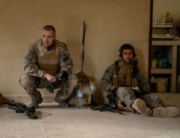Historical facts, interpretation, and blame are strikingly embodied by Benjamin Murmelstein. His singular life and experiences, during and after the Holocaust, have inspired magic realism fiction, including Leslie Epstein’s King of the Jews and André Schwarz-Bart’s The Last of the Just, referenced by this ironic title. Over a week in 1975, the then 50-year-old Claude Lanzmann interviewed the 80-year-old Viennese rabbi at his self-imposed exile in scenic Rome, where he lived until his death in 1989—his first interview in 30 years.
In the first interview the director filmed for 1985’s Shoah, Lanzmann establishes what would be his trademark technique. He first clarifies the chronology of events Murmelstein witnessed and the actions he undertook, then Lanzmann doggedly circles back on each year, and back again, to challenge with outside evidence and others’ charges on what Murmelstein knew and when. But the rabbi emphatically, and convincingly, insists on his own truths and credibility.
The first third of Murmelstein’s biography sets the stage for how the leadership of the Jewish community of Vienna coped with the Nazi takeover in 1938, and how he accidentally ended up as the community’s leader. For seven years, he negotiated personally with Adolf Eichmann, his Central Agency for Jewish Emigration, and successive authorities. Murmelstein even traveled to Germany to face the deceits, corruption, and the ever-increasing bureaucratic delays for more and more documentation and confiscatory fees and requirements. (He’s very specific about Eichmann’s profit motives.) Yet he succeeded in obtaining exit visas for more than 120,000, out of Vienna’s original population of more than 200,000 Jews. (The personal impact of these nerve wracking procedures can be heard in Gita Weinrauch Kaufman’s documentary Shadows From My Past, from her parents’ desperate letters to American relatives listing the escalating demands they were frantically trying to meet before getting the last permit out.)
Vividly, and most damning against the accepted version of history, Murmelstein emotionally describes the scene in the city’s main synagogue on Kristallnacht, the night of November 9, 1938, when he confronted Eichmann, who was enthusiastically leading the vandalism. This is not only a powerful, riveting story, but he directly contradicts Eichmann’s unchallenged 1961 testimony, that can be seen in Michael Prazan’s recent documentary The Trial of Adolf Eichmann.
So why wasn’t Murmelstein, a dedicated Zionist, called to testify in Israel? The second part of his biography meticulously details how he became such a detested pariah that the Jewish community would not listen to him. Interspersed with the 1975 interview, Lanzmann reads from Murmelstein’s self-published 1960 memoir, that hasn’t been translated into English, while standing at the locale he became notoriously associated with—Theresienstadt. An 18th century fortress, now in the Czech Republic, was converted into a model ghetto for Germanic Jews, particularly intellectuals, as a Potemkin village propaganda showplace (the Nazis’ promotional newsreel, seen in clips, called it “Hitler’s Gift to the Jews”).
By the time Murmelstein was deported there in 1942, as were 140,000 Jews, it was already a deplorable work camp and way station to the extermination camps. The community leaders the German administrators required would be summarily executed if they didn’t enforce directives with alacrity, which happened to his two designated predecessors as the elder. Murmelstein forcefully describes the impossible options he faced daily (“You can’t show you’re frightened”), and the crucial decisions he made to implement horrible triage that would save the strongest people under his supervision amidst the disease-breeding conditions of overcrowding, malnutrition, maltreatment, and relentless work quotas.
Unlike his earlier films, Lanzmann includes a sampling of the drawings that artists, such as Felix Bloch, secretly made as hidden evidence of the deadly conditions, which were retrieved after liberation. (Doug Shultz’s 2012 Defiant Requiem featured survivors’ accounts of the terrible conditions and the inmates’ creative survival mechanisms.) After Theresienstadt fulfilled the Nazis’ propaganda purposes at the end of 1944, the camp was liquidated and all deported to Auschwitz. (The oblivious interviewee in A Visitor from the Living was one of the Red Cross representatives, who sneered at how “robotic” the “elite” Jews” there seemed to him during the choreographed visit.)
But of all the Nazi-approved elders in each ghetto, only Murmelstein survived. Lanzmann asks him to reflect on being “the last of the Elders,” and the last third of his biography focuses on living with that anomaly after having had, as he described it, “power with no power.” In a unique challenge to the accusation of collaboration, he volunteered to be tried by the Czech authorities, among 100,000 who faced such charges there in retribution courts and tribunals. He notes “I could have left.” Instead he waited more than a year in prison until his acquittal.
That didn’t calm the furor of blame. Hanging over him, and his conversation with Lanzmann, is the example of Hungarian Rudolf Kasztner, who saved some Jews at the expense of others and was assassinated in Israel in 1957. (His fraught legacy of gratitude and resentment was explored in Gaylen Ross’s 2008 Killing Kasztner: The Jew Who Dealt with Nazis.) Lanzmann uses the writings of Hannah Arendt as Murmelstein’s prime accuser—both in terms of what more he could have done for the Jews of Vienna and Theresienstadt, and their conflicting impressions of Eichmann as a careerist vs. a corrupt anti-Semite.
Lanzmann conducts no dry ethics lesson here—it is made of flesh, blood, ghosts, and a fascinating man for the audience to finally judge.

















Leave A Comment